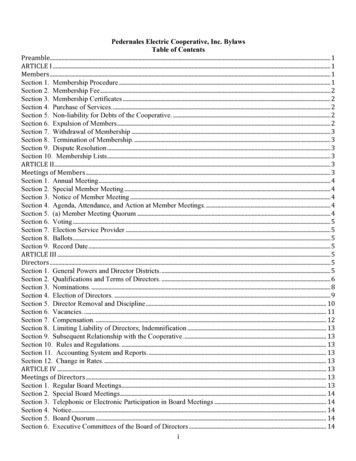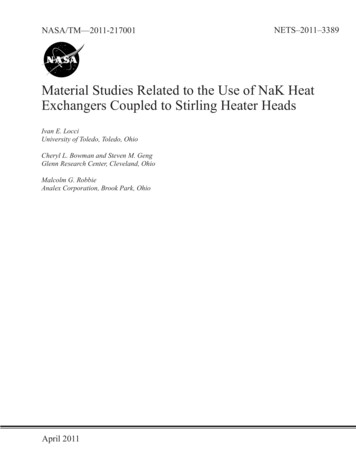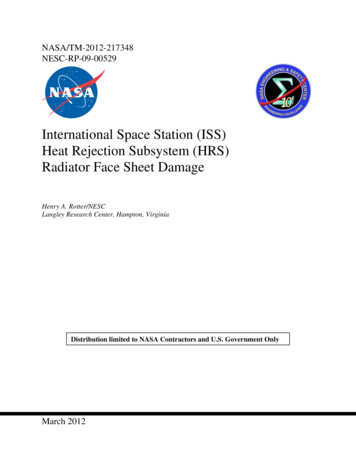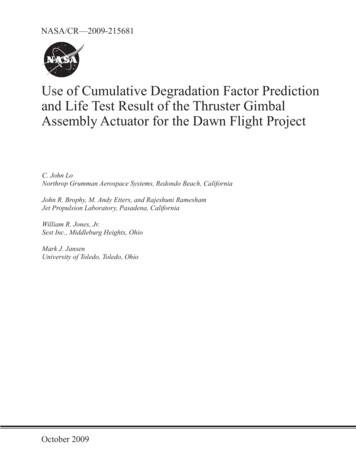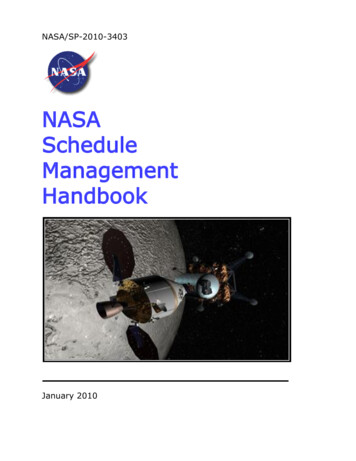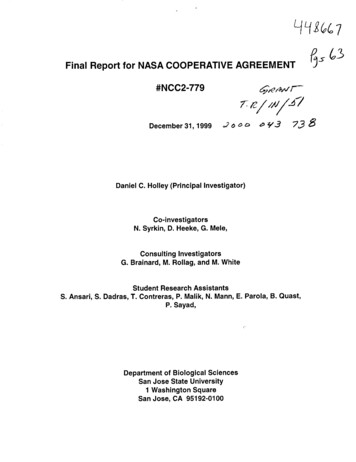
Transcription
Final Report for NASA COOPERATIVEAGREEMENT#NCC2-779December31, 1999Daniel C. Holley (PrincipalInvestigator)Co-investigatorsN. Syrkin, D. Heeke, G. Mele,Consulting InvestigatorsG. Brainard, M. Rollag, and M. WhiteS. Ansari,S. Dadras,Student Research AssistantsT. Contreras, P. Malik, N. Mann, E. Parola,P. Sayad,Department of Biological SciencesSan Jose State University1 Washington SquareSan Jose, CA 95192-0100B. Quast,
CONTENTSI*MelatoninSuppressionlux; and EffectsLightingStudy:LEDof 100 lux LEDon RetinalHistology,vs. CoollightingWhiteFluorescentvs. 100 lux Cooland RetinalPhysiologyWhite- 0.1, 1, 10, 40, 100Fluorescentas Determinedby ERGAnalysistH.CircadianBehavioralStudy:LEDvs. CoolWhiteFluorescentlux.HI.AppendixA.: RasterPlotsand FinalExperimentProtocols- 0.1, 1, 10, 40, 80
NASALED verification(CooperativeAgreementFinal SubprojectNASACOOPERATIVEPart I: nd MorphologyC. Holley,#NCC2-779and Cool White FluorescentPineal Gland MelatoninFunctionDanielReportNCC2-779)Ph.D.and Maintainin the Rat(PrincipalInvestigator)Co-investigatorsD. Heeke(MS Cand.),ConsultingG. Brainard,Ph.D.,G. MeleInvestigatorsM. Rollag,DepartmentSan JosePh.D.,of BiologicalState1 WashingtonSan Jose,(MS Cand.)CAand M. Retinal
dLight-EmittingDiodes and Cool WhiteFluorescentLight Similarly Suppress PinealGland Melatonin and Maintain RetinalFunctionDarrenBrainardS. Heeke2, Markand MorphologyI, MaryP. WhiteD. RollagI, Gary3, Charles'M.D. MeleWingetin the Rati, John4 andP. HanifinDaniel2, GeorgeC. HolleyC.tDepartment of Biological Sciences, San Jose State University, San Jose, CA 95t92-0100';Department ofNeurology,Jefferson Medical College, Philadelphia, PA 19107', Deparzment of.Smatomy, UniformedServices Universi of the Health Sciences. Bethesda, MD 208143, and Science Payloads OperationsBranch, National Aeronautics and Space Administration, Ames Research Center. Moffeu Field, CA 94035Key Words: circadianrhythm, electroretinography,LED, photobiolog ',retinal histology
1ABSTRACT2Currently,the light sources3fluorescentor incandescent4for use in animal5(CWF)6morphologyin the rat.7suppressionof pineal8light illuminances9me.latoninhabitatin suppressingpinealWe evaluatedby comparingglandResultswas evaluatedIlwave12LED-exposedrats and13no differencesin retinal14rats exposed15epitheliumand rod outer segments16thickness.This study17pineal18that LED light19lightingto 100-1uxmelatonin100-1uxLED and 100-1uxindicatesat similarsourcesof rodentor b-waverod gthof retinalas a anicalequalincontrols.betweenhistologythe retinaldamagein a-100-1uxassessmentof rod nucleilight source.for conventionalandno differenceswere in good conditionCWFphysiologyto unexposedFurthermore,retinallightdifferencesand numberfor 14 days.fluorescentshowedand amplitudesthat LED light does not causemay be suitablevivariumscomparedlight sourcelight at five differentwere no significantof all eyes observedintensitiesexperimentsare cool white(LED)retinalfor LED light and lightingto cool whiteusing electroretinography.and amplitudeshabitatlight-emittingLED and CWF light whenRetinaltimesmelatonin40, 10, I and 0.1 lux).10implicita noveland maintainingconcentrationsbetweenused in animalits effectivenessmelatoninof (100,most commonlyshowbetweenpigmentedand of normaland can suppressThesedata suggestlight sourcesand economicalused in theadvantages.
INTRODUCTION3Currently,4fluorescent5and incandescent6These7and shorter8animal9limitationsthe light sourcehiteincludelight,sometimeslights haverelativelyoperatingfacilitymost commonlyreferredcertainlife (1), all 2mechanical/sizeefficiency,light sourcelong ssionas an 0normaloftheto the retinabehavioral22phototoxic23editionwas to comparehealtheffects(2,3,4)highercostsruggednessof anmechanicaltechnologyincluding:lightheat production,operating(LED)advantageseffectWe measuredfunctionof light on the circadianwe comparedchangesoffersspectral(solida relativelycontrol,state),highand certainthe effectsstudy,pinealsince this is generallyacceptedsystemof rodents.Sinceof LED light to CWFwe compared(ERG),light inmelatoninas alight can belight on a) retinaland b) retinalmorphologyLED light to CWF light in maintaining(5).of light on circadianfor the Careof LED light to CWFlight-inducedin the electroretinogramrhythmicityeffect of light on the retinaof the GuidediodeCWFlight sources.they have certainthe effectivenessand well being.In a parallelcircadianThe profound21and has inherentof neuroendocrineusing light-inducedlight microscopy.Light emittinglight.(1).14measurealternativeof power),In addition,is broad-band(CWF)when consideringlife, low heat production,The purpose of this study13over low illuminance/wattsuch as their size and mass.I0to as cool v,hitedisadvantageslow efficiencyor certainused in animalunderphysiologycertainis well establishedconditionsand Use of LaboratoryAnimal.s(2.3.4).states,(6) as is theHowever,"Precisethe 1985lighting
Irequirementsfor vitystudies,NASAsponsored4intensityand ropriate8Guidespecifies9photoperiod(7).1996 editionof the phabitatof rodentsare amongfor the albinoaboutpreciseindicatedthat shouldroomrats'primatesbe consideredlighting(9).standardsvulnerabilityand efficientof the albinolightingTheforto elevatedlaboratorysystem(8).thatthat our data adds significantlyand well beingeconomicalAnimalsholdingalbinoWe believeon the healthrelativelyrat, but does not specifyalso warnsforand non-humanthe factorsfor animalare notconstructionwho recommendedand U.se of Laboratoryconsideredof animalsto therat and(e.g., LED)can beMETHODSand Measurementcommercially17of light that give distinct18arranged19light source2Oof blue,21Durham,22CA; yellowavailableused in theseyellowNC; greenLED,LEDscolor appearances.so as to approximatelygreen,for animalfor ourcesa workingThe Guideof light intensityfor animalspecificationsis beingstandardsthat an alternative,and physiologicaland wavelengthilluminationintensityhealthfor the Careof exposure,or wavelength.I016of goodmatchexperimentsare individualGroupsthe spectralconsistedand red LEDs (blue LED,LED, catalogcatalog# HLMP-3950,# HLMP-3850,bulbs that emit restrictedof monochromaticpowercatalogFutureand red LED,LEDs, however,distributionof circular(g-inchof CWF light.diameter),# C470-5C18,ActivecatalogbandwidthsElectronics,# HLMP-3750,The LEDhoneycombCree ResearchIndustrialcan bearraysInc.,San Jose,
!Hamilton/Halmark,2samespectral3usinga calibrated4scanning5Newburyport,6and LED light sources7animalsamount9standard chmentMA).Figureunit usedlight.1 showson a surfacefor specifyingIn the melatonin12with a 16the originalg-inch17circular18of the LED array.19(ModelA32681,20densityfilters21lights.The duration22LightCo., Philadelphia,meterwith a J 16 radiometerexperimentalfor buildings,study,(Modeland a remotelight was producedThe Corp.,Stratford,of the light pulsePA) attachedfor the 100-1uxwhichreferswhichOnceby an g-wattCWFbulb (catalogCompany.# FgT5,the overallwas automaticallymaximumby use ofathe intensitycontrolledPhilips6-inchN J) in all exposures.CT) were used to adjustOR).TheLighting,was modifiedarray to a more condensedBarrington,was set it wasInc., Beaverton,light array used in this experimentincreaseanimalsin terms oflux.illuminance(Tektronix,of LEDs helpedLux is theeye level were measuredprobehoneycomborto thehouseare characterizedCWFin humanthe daytime.buildingsat animals"Japan).Lightlight intensityeye duringLight from the LED array was also concentratedEdmundInc.,J6512The LED curvesincludingin the followingwere measuredMA) with aas lux) is used,the humantheInc., Newburyport,when discussingthat stimulateslightingLightdistributionflux" (knownthe light stimuliilluminancepowerto give approximatelydistributionsIL-780/SHD033,the spectralsuppressionpowerInternational(Modelthe term "luminousand poweredSpectralIL-1700.used in this study.this standard,pattern.were arrangedas CWF(Modelof light diameterilluminancefresnelGlasslensneutralof both experimentalby a variabletimer(Solarto an iris diaphragm.4
In the retinala Model(Modelradiometerilluminancesproduced#9089,by the photicSuppressionAll experimentsCollegeperformed12Institutional13pain and discomfort14Harlan15light:dark(LD) cycle (lights16The dailylight cycle was produced17Danvers,MA).ISlevel.19bulb behind a Kodak I A ).Directenergysensor(Modelwas measured# SED038,radiometer# 4945,(in laW/cm" ) with theSerialLight Inc., Newburypoand the photometerusingMA) v, ith ausing Y filter # 8990 and W diffuser# 2143MA).during the electroretinom'aphicBreedingwere reviewedusingFThe range ofassessmentwassensor.to assureanimals.AdultLaboratories.on 0600-1g00providedmaleSpragueCWFout underDavdeyof 2 weekslight sourcesKodak,Rochester,on a 12:!2experimentation.# F40-CW,of 60 6 lux (18 2 pW/cm:)filter (Eastmanany potentialrats (175-200g,before(catalogdim red light producedUniversityminimizedIN) were maintainedh) for a minimumby 40-wattby Jeffersonand San Jose Statethat experimentsIndianapolis,an illuminancewas carriedand approvedCare and Use Committeeand Use Committeeof experimentalwhich: 2064stimulusAnimalat the animal'sby a 25-wattNY).Sylvania,eyeincandescentThe red light had anof 0.4 - 1.5 lux.Each of the melatonin2122InstitutionalDawleyLight Inc., Nexvbur)port,in this studyMedicalSpragueInternationalSerialeye level were measuredStudyIIAnimalat animals'Internationalusing the same calibratedMelatoninilluminancesand an irradianceand W diffuser10IL-1700.# SED03g,filter #18629measuredstudy,Light Inc., Newbur?port,same calibrated9phototoxicityintensity)took placesuppressionexperimentsbetween0000 h and 0230(fivetotal: each representingh on separatedays.a differentEach exposure
Iincluded3 groupsof eightrats:a group exposedto CWF light, a2and an unexposed3and 8 animals4study.5light6the following7l.tW/cm:80.0369sourcecontrolgroup.per treatmentEach exposureilluminancesgroup,lastedLED and CWFt0was a modificationI1exposure,1215 7disrupter18an additional19with20a 1:64,00021R1055)22radioactivityto a light-tight(Kontes,were32.0 laW/cm 2 and34.8laW/cm:,suppressionFive differentcorrespondtop.W/cm 2, 11.50.30 laW/era 2 and 0.36 laW/cm:,exposedelsewhere(10,11).holdingbox whereby decapitationlater assayedby Rollagin 200 laL PBS-0.1%Vineland,180 L PBS-0.N J).Duplicate1% gelatin.100 iaL of [125I] (40,000cpm/100dilution1.0 lux, and 0.1 lux whichgroupsto their respectiveand pinealbox.lightThe exposureFollovdngthe 5-minsystemlightthey were held in darknessglandswere removed,forplacedin aat -20 C.(ILIA) describedwere suspendeddescribed3 treatmentthe rats were dark-adapted.2. Rats were individuallythen euthanizedglandsand 3.23to the LED arraywere used in the melatoninrespectively:laW/cm"apparatusplate and frozenThe pinealwhileexposedilluminances,5 min in a 18.5 x 10.5 x 12.5 cm flat blackrats were transferredRats werea total of 120 animalsirradiances,W/cm(LED or CWF)for5 different100 lux, 40 lux, 10 lux,and 13.0 }aW/cm:, 3.40and 0.044using5 min and occurredwere tested:W/cm:Therefore,groupof rabbitto give a final volumewas precipitatedEachfor melatonincontentand Niswendergelatin20- Lduplicate(antibodyraisedof 400 laL. After a 2-dayby adding3mL cold (4 C)a modificationIn this procedure,of the sonicantlaL) melatoninby Markincubationof thepinealwith a microultrasonic(200 L volume)tL or 57,000dpm/100antiserum(12).and dispersedsamplesusingD. Roilagcellwere each placedintowas then incubatedanalogandon 9/16/74100 L ofin rabbitat 4 C, antibody-bound96% ethanolto the incubationmixture;8
andcentrifugingless thanat !00010% each.exposedgroupwere inance.RetinalPhototoxicitygroupsall data fromcontrolof variancedifferencesfor multiplecomparisonsdifferenceswerewerean LED-cohort.LED-exposed(Kruskal-WaUiswhereof variationgroup,the CWF.exposed,SignificantperformedInstitutionalin this study wereStatet3minimized14phototoxicityt5Sixteen16this experimentand were housedt7(CWF-exposedrats) and two experimental18housed19Cleveland,20arrays.2tin a cylindrical22uniformany ups werefurther analyzedusing thewith an experiment-wisein a chamberDawleyLED-exposedof experimentalwere housed underrats (300-350g,and testedfitted with two14-watttogetherlight exposureto the animaland approvedto assurealpha of 0.05in groupsCWFbulbs (catalogin a separateand 8 inchesor CWF lighting.Gilroy,rats).# GE FI4TI2,chamberin height).animalsCWF-exposedrats wereGE Lighting,fitted with two LEDfitted with aluminumas well as an unobstructedCA) were used inof four: two control(LED-exposedcagesIn the retinalLED lightingLaboratories.by the San Josethat experimentsanimals.animalsrats were housedin diametereitherSimonsenrats were kept in shoebox-typering (8 inchesreviewedCare and Use Committeepain and discomfortthe animalsmale SpragueIndividualan unexposedfrom one light illuminancewere unequal),12OH).coefficientsStudyAll experimentsUniversityincludedby analysisMethodfor eachIIassaygroupifp 0.05.Student-Newrnan-Keulsi0The intra- and interassaystudy (each illuminance),animalsbecauseEach melatoninand a CWF-exposedFor eachcontrolx g for 30 min.sheet metal shapedThis design helpedlight path.provideThe light sources7
Iwere2exposed3was produced4between5adjusting6study was 100 lux (corresponding7tW/cm:8fluorescentlight and the other exposing9maintainedso as to keep externalmountedfrom the ceilingsdirectlyfrom overheadby maskingwith one CWFthe CWFthe distancebetweenwith lights12important13changes14measured15and maintenance16Rochester,17Electroretinographyon at 0700factorsin 1photoreceptorchambers,light sourcethe extentand morphologywas done underirradiancewas establishedbyused in thisfrom the LED panelone exposingbethe distanceThe illuminanceand 30.1two rats to CWFfollowingtoxic12:12 LD cyclesand the cyclicof light-induceddim red lightingretinaland(KodakdamageSafelight(14).for 14 days,lightinglight exposurelight exposureschedule(13).Quantitativeare mostreliablyAll animal#2 - EastmanarehandlingKodak,of 0.4 - 1.5 lux.day of the retinal phototoxicityovernightusingof exposurethe start of toxichad an illuminancedark adaptationCWFtwo rats to LED light, were both constructedthe durationon the 14 m day or beyond19LED irradiancewouldlight from entering.when determiningOn the fifteenth18The two exposureThe desiredfoil as well as adjustingwere 28.5 tW/cm'to their respectivehours.NY) whichThe desiredirradiancesthat each animalbulb or LED panel.the LED panel and the rat cages.from the CWF source).IIto ensurebulbs v,ith aluminumthe CWF bulbs and the rat cages.Rats were exposedIOof each of the chambers,study, rats were movedto a darkroom(the last dark cycle of the 14 m day) for scotopic(ERG) assessment.cells that are best studiedNinetyfive percentin dark adaptationof the rat retina(15).is comprisedERG was performedof rodon the rats
in the morningsheddingno earlierthan 0930hoursto avoidvariabilityassociatedwith photoreceptordisc(16).3The rats were injected4Pupils were dilatedwith5held open and the e10% phenylephrinewas protectedproducingMA)i.p. with urethanewhiteon the cornea,10cheek.The ityrepresented19maximal130 lux to 0.1 lux.2orecording21neutraland displayedCT).distanceof 9 cm individuals,a 0.5-logan ERGERG recordingERGand steppingInstruments,in the rats.Monocularwire as the recordingand l-kHzon the(highand amplitudesystem(RetinoGraphics,of light iatensitywhich adjusts the powerof the stimulusfilters in the path of the light.Inc.,was a blue LED light placed aThis methodologyconfirmeddown to the lowestThe range of illuminancewasAwaswith the Grass PS22to a series of brief flashes varying in intensityintensityThe rangeeyelidand a ground electrodethe entire retina.waveformssolution).Grass Medicalfor cursor placementused in the ERG recordingswith eliciteddrops.response(low frequency)the eye to illuminateunit.Stimulator,on the foreheadBPM-100ERG responsesat the highestthe rat'sloop of platinum-iridiumon a PC monitorThe photic stimulusPhotowith 0.l-kHzusing the computerizedAider anesthesia,to confirmelectrodewere AC-amplifiedcutoffs20% aqueousfrom drying with methylcelluloseusing a 3ram diametera referencebody weight;eye drops.light (Grass PS22was used as a stimuluswere obtained(0.15g/kgintensity.wereEach step inof the brief flashes was from awas controlledelectricallyby the BPM-100ratherERGthan by placementof
The averageintervalof eight responsesof 20 seconds.determineLater the ERGthe a- and b-wavethe stimulusintensityway-ANOVAsubjectsconfirmedwhereby directexperiment.Uponresultsenergyand rement,an interstimulusplacementtovalueswere plottedagainstStatisticalevaluationof the dataused ofactorand light sourcesignificantdata collection,in modifiedgithusing cursorTheseifp 0.05.at the beginningof ERGand placedmeasuredtimes.as a within-subjectswerecompletionat each intensity,and implicit(intensity-responseright eyes were removed10waveformsamplitudesv,ith ERG stimulusfactor,was obtainedas a between-Stimulusof the experimentintensityand at the end of theeach rat was sacrificedKarnovsky'sfixativewaswith CO,- gas.for histologicalThepreparationHistologyTo determinewhether13rats of the retinal14total retinal15LED-housed163 control17to the experimental18(250 lux, lights on at 0700)19modified2Oat least 72 hours.21on the verticallight 'sto the ERG procedure.in an animalfixativebut maintainedvivarium(1% paraformalyde,and embeddedrod outer segments,histological7 of the CWF-housedenvironments,Follov, ing fixation,meridianThe quantitativestudy,rats that were not subjectedin the retinas of the LED and CWF.exposedthe retinal epithelium,were inspected.rats from the ERGoccurredanalysiswas carried out on 7rats from the ERG study,The 3 controlEyes were fixed1.5% glutaraldehydeeach eye was postfixedof CWFlightby immersionin cacodylatein 2% osmiumas well asrats were not exposedon a 12:12 LD cyclefor 14 days.in epon-aralditerod nuclei, andtetroxide,buffer)inforbisectedplastic.10
The retinalInstruments).examinedSemi-thinon a Nikonmeasurementsoptictissue was sectionedweresectionsresearchwith a Sorvalwere stainedmicroscopeJB-4ultramicrotomewith toluidineblue (!% in 1% borax)with an ocular micrometermade under 100x oil immersion(Dupontat 270 micronsattachment.and wereRetinaland 450 micronsfrom thenerve head.The was inspectedepithelium,vacuolationand vesicles.and observedwas countedfor any signsperpendicularof damagewas measuredperpendicularI!used one-wa ANOVA,120.05.13RESULTSto the reas oflengthThe numberLastly.epithelium.betweenof missingThe rod outer segmentand disorganization.to the retinal pigmentedIOfor the presencewasof rod nucleithe thicknessof the retinaStatisticalevaluationof the datawere consideredsignificantif p 1415MelatoninSuppression2 showsStudy16Figurethe pineal17their respective18differentdays (often19groups.In both experimental2O(lO0,21control22induced23the samelight nsBecauseby weeks),animalslight conditions40, 10. l, and 0.1 lux), the rats showedvs. CWFand controlby an LED illuminanceilluminanceof CWFvs. LED;Tablesignificantlylight (p 0.05for each of the 3 groupseach light exposurewere compared(CWFand LED).significantmelatoninexperimenttook place onto their respectiveat all illuminancessuppression1). In no case was the melatonindifferentof rats atfrom the melatonincontrolexamined(p 0.05 forsuppressionsuppressionelicitedbyfor LED vs. CWF at all illuminances).II
For the 100-1ux intensity ,CWF,and LED groups 71. andshowed(mean(meanCWF, SEM),(meanand LED groups158 z 12 pg/gland(mean SEM),showedand LED groups164 12 pg/glandthe control.of 464 85.239 SEM),CW'F, and LED groupsthe control.experiment,showed SEM),showed SEM),StudyNo evidence of retinal phototoxicity13CWF,the control,of 650 124, 218 42. andFor the 0. l-lux intensitymelatoninthe control,of 353 34, 257 13. and 231 6 pg/glandFor the 1.0-1ux iment,(meanof 1569 126, 365 34. and 462 50 pg/glandFor the 10-1ux intensityrespectively.pinealof 1166 136, 393 41. and 439 25 pg/glandFor the 40-1uxmelatoninthe control. CWF. and LED groups showed pinealExamples of individualwas found in the ERG responses from rats housed14in LED or CWF light.ERG waveforrnsare shown in Figure 3. ERG15response-intensity16Figures 4 and 5 plot the a-wave implicit times and amplitudesfor the LED and CWF groups.17Figuresfor the LED and CWF18ERG a-waves were rarely observed in the lower photic stimulus19below the -1.5 log intensity in both LED and CWF animals.20amplitudes21treatment/exposure22b-wave implicit times and amplitudescurves are shown (mean 1 S.D.) for both exposure groups in Figures 4 - 7.6 and 7 plot the b-waveimplicittimesand amplitudesof the ERG a- and b-waves were not significantlygroups (Table 2: Light Source).as expectedgroups.intensities and were undetectableThe mean implicit times anddifferent for the twoERG stimulusintensity affected a-wave and(Table 2: ERG Stimulus).Lastly, there was no12
interactionbetween2: LightsourceRetinalHistology4light sourcex ERGNo evidenceand ERGofphototoxicityresultsof the quantitative6retinalpigmented7their thicknesswas normal.scontrolgroupsin the measurements9nuclei,or overallIoDISCUSSIONThis study showsequivalent13we have ationalstandards19reportedhere in terms20(laW/era:)or retinalNo significantthat a novelLED light to maintainsuch as grossfor greaterare no f photometry.utilitylighting.numberLED,of outer(Tablepinealglandat similarintensitydifferencesin retinalfunctionfor animalsIn addition,drinkingour parallelas assessedand clearlayerANOVA).light sourceWe have reportedto the researchThe retinas,betweencan suppressentrainmentin animalfoundlength,by light microscopy)to CWFfi r specifyingwere3, one-wayCWF3 showsof all the eyes were in gooddifferences(TableTableon the rat retinas.LED light source(determinedexposedmorphology.of rod outer segmentof the retinathat thereto animalsperformedto a conventionalstructurein retinaland rod outer segments,thicknessconcentrationswas foundmeasurementsepithelium12for any of the four ERG inlevels.Also,(determinedexposedto LEDsstudyas reportedthroughbehavioralTo compare(9). we haveour light intensitiesour resultsframedbyin (5),tothe studiesin radiometrictermscommunity.13
!Light suppressionof2it is a gnals8rapidsuppression9TheThe sensitiveinitiallyglandof the effectsnaturedemonstratedto light duringinducesof pinealmetabolismrhythmsin mammals,11(20).12(21) and gy.This responseknownthe rh thmic(22) of the light.LED light and CWFlight.in melatoninsuppressionto LED light at illuminancesat the atonin.significantlythat it can be equallyFurtherrangingilluminanceeffectivetests on otherThe exposurelaboratorynucleiof pinealof the hypothalamusgland whichglandpinealand secretionsynthesisfromindicaterats exposedlowerintensitiesin regulatingparameterscomparableother aspectsare requiredthat thereis noThe significantof CWFof LED light to suppressat low illuminances,comparisonto CWF light and rats100 lux to 0.1 lux.that evento suppressa meaningfulfrom these experimentsbetweenof melatoninon the intensityof each light sourceused provided(19).for circadianaxis to light is dependentthe abilityleads tomelatoninpacemakersglandratpathway,to be the endogenousThe abilitycircadianand otherof the mammalianto the pinealloweringintensitiesThe dataof rodentsaxis in the whiteare transmittedTherefore,at each of the lightin this study becausein the retinohypothalamicof the gnalsand subsequenthave beenincludingmelatoninas a bioassayin the suprachiasmaticnucleienzymesnucleiand colleaguesneuronalfrom the suprachiasmatic10was usedof light on the circadianby Mirmemanglucosesuprachiasmaticmelatoninof the retinal-h,,9othalamic-pinealthe nightin turn elevatesglandpinealand LED lightpinealglandto that of the CWF light,of circadianto confirmsystemthis.14
ILight exposurepartialcan causeor total blindnessretinal2causing3the LED arrays causedphototoxicity4LEDs,is produced5determine6on the retina,7lighting8it would9oftheas light damagewhether(2,3,4,23,24).morewe comparedfunctionbe observedeffectsliretinal12by the photoreceptor13of the intact retina, is a result of c-pinealigof physiologicaland behavioral19does not reducephotoreceptorepithelium(25).can be relatedThe a-wavecells (25).as a result of on-bipolarin amplitudeloss.order22shownin animalexcitationwhichto loss of e presencedegenerationand CWF animalfunctionalfunction,retinalof signalsThe resultsmass responsecomponentsfunctionof thein albinoproducedof the ERGin Mullerwould be indicateda reducedsensitivityphototoxicityassessmentby theto light ormay also affect thefrom the eye to the centralof the ERGfollowingof any photoreceptorto occurto the retina,ion concentrationsor disrupt retinal functionwas performeddamageand is the componentpotassiumshowingeffectlayers of the neural retina and theERGLoss of retinalTohabitatis the most salient fast potentialin extracellular(25).light (2).have any deleteriousof the individualcellularwhetherband in componentThe ERG is the evokedis the first part oftheaxis due to the transmissionto determinelightingcells,to determineof visiblewouldIf there ,,'asto specificThe b-wave,importantwavelengthshabitatshabitatof the ERG a- and b-waves,In additionMorphological21by someThe amplitudescompositeloss of photoreceptorwavelengthin the electroretinogram.I02oreadilyusing ERG assessment.by changeswaveformof the narrowof LED animalto a flash of light (25).ERGand irreversibleIt was especiallybecausethe use of LED lightingon retinalretinadamageshowpacemakerthat LED(Figures 4 - 7).the ERG functionalassessmentcell damageor death.Past findingsrats exposedto light intensitiesinhavegreaterthan15
60 lux for 13 weeksdegenerationdata obtaineddays using5a 12:12in rats exposedhistological3usinga nderstoodin our studydoesthe effectsthe interactionis the studyrelativein termsiIof generalcommunication,12categoriesof light meter17whileIsduringthe daytime.19which"shape"2ohumanvisual21photometryis a special22serviceablenomenclatureon the selectivemeasuresa photometerthe radiantmeasurespowerA photometerthe detectorresponsesensitivityof the "standardbranchsystem,as a descriptorLight,herehowever,in photobiology.of the humanimportanta radiometerof the(29). Radiometrysystemin photobiologicalover a definedthat stimulatesthat has filtersas determinedby the CIE (30).the photometricfor describing(29,30).Athe humaneyeadded to the detectorobserver"techniquewhereasrange of wavelengths,(brightness)and measurementisresearch.the luminanceAlthoughitfor purposesand wavelength,visualon a surfacediscussThere are two broadto resembleof radiometry.is oftenof light is serviceableand photometricofSpecifically,most individualssuch as its energyflux fallingthe disciplineportions(27,28).This descriptionof light,for 14(,Table 3).and ultravioletradiometricTheLED lightingvisibleof a light sourceis simply100-1uxorganisms.is particularlythe luminousthatand livingresponsivenessof stimuli14:10 LD cycle (4).radiationvisualpropertiesno signs of retinalinvolvesto the humantechniques:showedphysiologyprocessesbut is less usefulquantificationdamagebiologicalcolor and brightness.on the physicalis basedthe conclusionretinalopticalstudyusingof light on mammalianbetweenl0exclusivelynot causeinfluenceand describedof its apparentsupportof how the infrared,spectrumAnotherto 194 lux for 4 - 6 monthsLD cycleInvestigatingLD cycle (26).responseof theThus,system providesthe light stimuliaused in this16
Imanuscript,it does not imply that the investigators2relevant3physiolog2,.4is very unlikely5the input6terms7animal8regulation9theseto
3 fluorescent or incandescent lamps. We evaluated a novel light-emitting diode (LED) light source 4 for use in animal habitat lighting by comparing its effectiveness to cool white fluorescent light 5 (CWF) in suppressing pineal gland melatonin and maintaini



